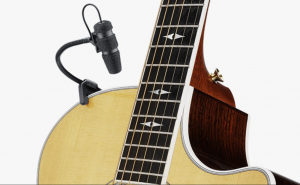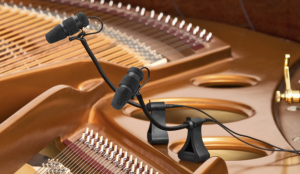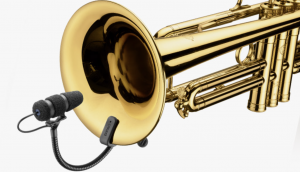
Feedback in a sound system is that annoying howling or squealing tone you hear when the microphones pick up amplified sound from the loudspeakers. Sound from the speakers enters the mics, is re-amplified, and goes around in a feedback loop. Almost instantly, the sound builds up until a loud ring occurs – usually at a single frequency.
Fortunately, there are many ways to kill feedback or prevent it in the first place.
Quick Fixes
Before the service, on each mixer fader, mark the point
where feedback occurs. Don’t exceed that point during the service. If you still hear feedback during the service, turn down the house master faders or the monitor master until feedback stops. If you know which mic is causing the feedback, turn down its fader or monitor send, or cut EQ at the frequency which is feeding back.
Use as Few Mics as Possible
The more mics you have in use, the more likely you are to run into feedback. The gain – before – feedback decreases 3 dB each time the number of open mics doubles. Two mics have 3 dB less gain than one mic; four mics have 3 dB less gain than two mics, and so on.
To reduce the number of open mic uses at the moment, you might prefer to turn them down about 12 dB, rather than off, so you don’t miss cues.
Instead of turning mics down manually, you might want to do it automatically with an automatic (gated) mic mixer. It reduces the gain of mics that are picking up little or no sound at the moment. This cuts down the risk of feedback by keeping the number of open mics at a minimum.
With electric guitar and bass, try using direct boxes instead of mics. Direct boxes pick up no feedback. You can plug the direct box into the musician’s effects output or plug directly into the bass guitar.
Place Speakers and Mics Far Apart
This weakens the sound traveling from speaker to mic, so it diminishes the feedback loop.
Try to mount the house speakers raised up high, away from the mics. Also, use directional speakers that focus the sound on the audience.
Use Unidirectional Mics
These reduce feedback and leakage. A unidirectional mic rejects sounds to the sides and rear of the mic, such as floor monitors. Some examples of unidirectional patterns are cardioid, supercardioid, and hypercardioid. Most uni mics boost the bass when you mike close. This is called the proximity effect. At low frequencies, it provides free gain (extra volume without feedback). If you want to roll off this excess bass with your mixer EQ, you also reduce any low-frequency feedback picked up by the mic.
Place Speakers Behind Mics
With any unidirectional mic, there is a certain angle behind the mic where sound pickup is least. This angle where the mic is relatively “dead” is called the null angle. Place monitor speakers in the null of the mic.
For example, a cardioid mic is least sensitive in the rear. So you’d place the floor monitor directly behind the mic. A supercardioid has two nulls of least pickup at 125 degrees either side off-axis. Place the monitors there for least feedback.
Mike Close
Close miking increases the sound level at the microphone and makes the sound system louder. Place each mic within a few inches of its sound source (except for the choir). Keep mics as close as possible, but no closer than necessary to get enough volume before feedback occurs.
If a person speaking is not loud enough through the PA without feedback, do this: Move the mic closer to the person speaking, or ask them to talk closer to the mic. Demonstrate to them how they can’t be heard if they’re too far from the mic. If you’re miking a group of singers with a single microphone, and you get feedback from the floor monitors, give each performer a close-up mic instead.
Although close miking boosts the sound level, it tends to color the tone quality, giving an unnatural sound. Here’s why: Most musical instruments are designed to sound best at a distance (say, 1 or more feet away). So, a flat-response mic placed there tends to pick up a natural or well-balanced timbre. But when you mike close, you emphasize the part of the instrument nearest the mic. The tone quality that is picked up very close may not reflect the tone quality of the entire instrument.
For example, the sound hole of an acoustic guitar resonates strongly around 80 to 100 Hz. A mic placed close to the sound hole hears and emphasizes this low-frequency resonance, producing a bassy, boomy timbre that does not exist at a greater miking distance. The close-miked sound is harsh, too. To make the guitar sound more natural when miked close to the sound hole, you need to roll off the excess bass on your mixer or use a mic with a bass roll off in its frequency response. Also dip out some 3K to reduce harshness.
A sax miked in the bell sounds like a kazoo. To mellow it out, cut around 3 kHz and boost around 300 Hz. Better yet, mic above the bell so you pick up the tone holes.
Use Noise-Canceling Mics
A noise-canceling or differential mic for vocals is designed to cancel sounds at a distance, such as instruments on stage or monitor speakers. Such a mic provides outstanding gain-before-feedback and almost total isolation.
The differential mic was designed to cancel sounds beyond a few inches away, such as musical instruments on stage. As a result, many users have reported that their house mix has improved because the mic’s isolation is nearly complete. In other words, “Mic 1” is no longer vocals and some drums, guitar, and bass. “Mic 1” is vocals only.
Singers must use a differential mic with their lips touching the grille otherwise their voice gets canceled. This restriction is not a problem because many singers already kiss the mic. It can be a drawback if the singer likes to work the mic for effect.
A cardioid differential mic also rejects sound behind the microphone, such as a floor monitor. This type of mic is available in handheld and headworn models.
Try Mini-Mics
Miniature clip-on mics are designed to mount on musical instruments. Since each mic is very close to its instrument, it picks up a high sound level. So you can often use an omni-directional mini mic without feedback. Omni’s generally have a wider, smoother response than uni’s and pick up less mechanical vibration.
Tape an omni mic inside an acoustic guitar against the side nearest the performer, so that the mic can “see” the strings. EQ for a natural tone quality. Tape one to a flute between the lip plate and finger holes, about 2 inches from the lip plate and 2 inches above the flute. It sounds much more natural than a pickup. For a grand piano, tape two mini mics to the underside of the raised lid, over the bass and treble strings. If necessary, close the lid for more isolation.
Use Contact Pickups Mixed with Mics
A contact pickup can solve feedback problems because it is not sensitive to sound waves. It only picks up mechanical vibrations. A pickup for an acoustic guitar usually sounds good near or under the bridge. Unfortunately, the guitar might sound “electric” with a pickup because the pickup misses the acoustic string sounds.
Many engineers have had success with a hybrid method that combines a pickup with a mini mic. A pickup is mounted under the bridge to pick up the lows and provide volume and punch. A mini hypercardioid mic is mounted just inside the sound hole facing in. It provides the treble and the acoustic string sound.
The pickup and microphone are mixed in a small 2-input mixer provided as part of the system. You get a loud, punchy signal with a natural string sound.
As for the piano, some engineers have had luck with C-Ducer tape. This is piezo electric plastic tape which you mount on the sound board.
Turn Down the Monitors
Stage monitor speakers are the main cause of feedback. Loud monitors leak sound into the vocal mics, causing feedback and coloring the sound. Try to keep the monitor levels down. Explain to the musicians that overly loud monitors cause feedback.
Use In-Ear Monitors
Instead of using monitor speakers, consider using in-the-ear monitors or earphones. They don’t feedback.
Equalize the Floor Monitors
A handy tool for removing frequencies that feed back is a graphic equalizer. The equalizer has a row of sliding controls that affect the level or loudness of various frequency bands from low to high. You connect this device between the mixer output and the input to your monitor speaker power amp. Basically, you find the frequencies that are feeding back, and turn them down on the equalizer.
Automatic feedback suppressers, such as made by Sabine and Shure, will do this for you. They quickly sense feedback and determine its frequency. Then they assign a narrow notch filter at the same frequency, which eliminates the feedback. Several filters are assigned for different feedback frequencies.
If you want to use a graphic equalizer, follow these steps: Set all the graphic-equalizer controls to their center position (“flat”). The rows of sliding volume controls toward the left of the equalizer affect low frequencies; those on the right affect high frequencies. If you push a control up (apply boost), the level or volume increases at a particular frequency. If you push a control down (apply cut), the volume decreases at that frequency.
Set up a normal monitor mix. Now slowly turn up the mixer’s master monitor volume control to bring up the volume in the monitor speakers. The system will start to feed back (ring or squeal), and the feedback will sound like a musical note or tone.
Try to find this note on the equalizer by cutting (pushing down) each control in turn. The control knob which stops the feedback is the correct one. Lower this control just to the point where the feedback stops. Then turn up the monitor volume until the system feeds back again (usually at a different frequency). Lower the control for that frequency until feedback stops.
Repeat this procedure several times, turning up the overall volume as feedback is suppressed, so that three-to-five frequency ranges are cut. You should be able to play the monitor speakers louder without feedback than you did before equalization.










